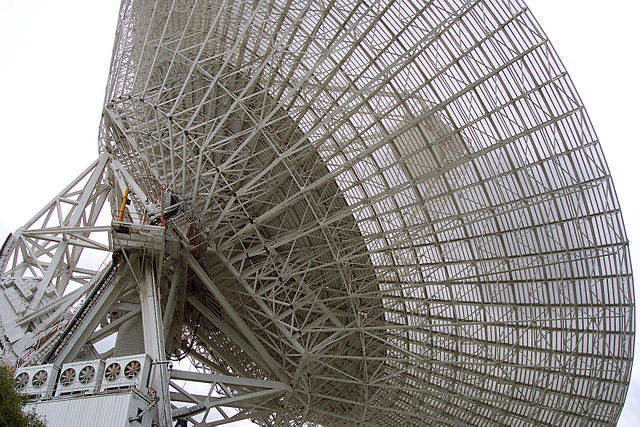Canberra Deep Space Communication Complex
Interplanetary radio communication station From Wikipedia, the free encyclopedia
Interplanetary radio communication station From Wikipedia, the free encyclopedia
The Canberra Deep Space Communication Complex (CDSCC) is a satellite communication station, part of the Deep Space Network of NASA's Jet Propulsion Laboratory (JPL), located at Tidbinbilla in the Australian Capital Territory. Opened in 1965, the complex was used for tracking the Apollo Lunar Module, and along with its two sister stations at Goldstone, California and Madrid, Spain is now used for tracking and communicating with NASA's spacecraft, particularly interplanetary missions. Its DSS-43 antenna is the only antenna on Earth that can send commands to Voyager 2. It is managed in Australia by the Commonwealth Scientific and Industrial Research Organisation (CSIRO) for NASA’s Space Communications and Navigation program (SCaN) at NASA Headquarters in Washington, D.C.[1]
 The Canberra Deep Space Communication Complex in 2010 | |
| Alternative names | CDSCC |
|---|---|
| Organization | CSIRO / NASA / JPL |
| Location | Tidbinbilla, Australian Capital Territory, Australia |
| Coordinates | 35°24′05″S 148°58′54″E |
| Altitude | 550 m |
| Established | 19 March 1965 |
| Website | www.cdscc.nasa.gov |
| Telescopes | |
| Telescopes | |
| | |

The complex is located in the Paddys River (a tributary of the Cotter River) valley, about 20 km from Canberra in the Australian Capital Territory. The complex is part of the Deep Space Network run by NASA's Jet Propulsion Laboratory (JPL). It is commonly referred to as the Tidbinbilla Deep Space Tracking Station and was officially opened on 19 March 1965 by then Prime Minister of Australia Sir Robert Menzies.
The station is separated from Canberra by the Murrumbidgee River and, more importantly, the Coolamon Ridge, Urambi Hills, and Bullen Range, which help shield the dishes from the city's radio frequency (RF) noise. Located nearby is the Tidbinbilla Nature Reserve.
The CSIRO manages most of NASA's activities in Australia.
In February 2010 CSIRO took over direct management of the site with the establishment of CASS (CSIRO Astronomy and Space Science).[2] Previous to this CDSCC had been managed by external sub-contractor organisations, such as Raytheon Australia from 2003–2010;[3] BAE Systems (formerly British Aerospace Australia) 1990–2003; AWA Electronic Services -1990.[4]


During the mid 1960s NASA built three tracking stations in the Australian Capital Territory.

As of late 2016 the station has five large antennas, called Deep Space Stations (DSS), each identified by a number: DSS-34, DSS-35, DSS-36, DSS-43, and DSS-45. The CDSCC also uses the Parkes radio telescope in central New South Wales at busy times to receive data from spacecraft (then designated DSS-49). There has been ongoing construction since 2010 building additional 34 m beam waveguide antenna. Construction of DSS-35 began in July 2010.[5] The station's collimation tower is located approximately 3 km to the north-west, on Black Hill.
| Photo | Designation | Status | Main aperture | Notes |
|---|---|---|---|---|
| DSS-33 | Decommissioned | 11m | A small A/E antenna which was decommissioned for DSN use in 2002 and moved to Norway in 2009 to be used for atmospheric research.[6] | |
| DSS-34 | Active | 34m | Beam waveguide antenna, uses a system of radio frequency mirrors to place the receiving and transmitting hardware underground rather than on top of the dish. Built in 1997. | |
| DSS-35 | Active | 34m | Operational in late 2014 and officially opened in March 2015. | |
| DSS-36 | Active | 34m | Dish installed August 2015. Operational late 2016 and officially opened on 3 November 2016.[7] | |
| DSS-42 | Decommissioned | 34m | Decommissioned in 2000 and dismantled shortly after. This was an "hour angle declination" antenna and was the original antenna constructed at the complex. | |
 | DSS-43 | Active | 70m | Originally constructed as a 64 m dish in 1973 and enlarged in 1987. It is the largest steerable parabolic antenna in the Southern Hemisphere. It is used by NASA to communicate with Voyager 2; the only antenna remaining on Earth capable to do so.[8] The antenna weighs more than 3000 tonnes and rotates on a film of oil approximately 0.17mm thick. The reflector surface is made up of 1,272 aluminium panels with a total surface area of 4,180 square metres. |
| DSS-45 | Decommissioned | 34m | Built in 1986. Decommissioned November 2016 soon after DSS-36 became fully operational. | |
 | DSS-44 DSS-46 | Decommissioned | 26m | Originally was constructed in 1967 for the Manned Spaceflight Network (MSFN) at Honeysuckle Creek near Canberra. It was one of three main ground stations for the Apollo program. While in the MSFN the station and its 26m dish had the designation HSK. In 1974 after the Apollo program had finished the station was transferred to JPL's Deep Space Network (DSN) and given the designation DSS-44. In 1984 the Honeysuckle complex was wound up, the antenna was dismantled and reassembled as DSS-46 at the CDSCC (Tidbinbilla) complex about 20 km away.
DSS-46 was decommissioned in late 2009. In May 2010 the American Institute of Aeronautics and Astronautics declared the antenna a Historical Aerospace Site, and the antenna remains in place.[9] |
 | DSS-49 | Active | 64m | Radio telescope at Parkes Observatory, capable of linking in to provide support, though it is a receiver only and is incapable of transmitting. |
CDSCC costs about A$20 million per year to run, and is funded by NASA.[10][11]
Seamless Wikipedia browsing. On steroids.
Every time you click a link to Wikipedia, Wiktionary or Wikiquote in your browser's search results, it will show the modern Wikiwand interface.
Wikiwand extension is a five stars, simple, with minimum permission required to keep your browsing private, safe and transparent.